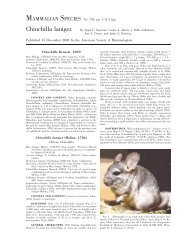Brugia Malayi - Clark Science Center - Smith College
Brugia Malayi - Clark Science Center - Smith College
Brugia Malayi - Clark Science Center - Smith College
You also want an ePaper? Increase the reach of your titles
YUMPU automatically turns print PDFs into web optimized ePapers that Google loves.
Investigation of a Molecular Mechanism for Anesthetic Preconditioning<br />
Alexis Ziemba<br />
Anesthetic preconditioning (AP) is a potential treatment for patients undergoing procedures that are accompanied by a high risk<br />
for ischemic injury (e.g. perioperative stroke) and cannot be treated by anti-coagulants. AP is a phenomenon by which tissues are<br />
pre-treated with clinical concentrations of a general anesthetic; this minor insult results in the upregulation of cellular protective<br />
measures, which defend against greater insults such as ischemia. Our lab aims to discern the mechanisms by which this protection<br />
occurs. We have proposed that exposure to the general anesthetic, isoflurane, increases the level of the signaling molecule nitric<br />
oxide (NO) 2 , with astrocytes being the major producer of NO 1 . This triggers a downstream increase of free intracellular Zn 2+<br />
(Figure 1). 5<br />
To first confirm increases in NO following isoflurane exposure, isolated astrocytes were exposed to isoflurane in a dedicated<br />
anesthetic chamber. The level of NO was measured six hours later using the Griess Reaction, a chemical analysis test. No<br />
difference was seen in the level of NO following isoflurane exposure. As changes in the level of NO were shown to be timedependent<br />
in the cell type, microglia, earlier time points will be tested in astrocytes.<br />
To determine if there are increases in intracellular free Zn 2+ post-isoflurane exposure, dissociated brain suspensions were<br />
incubated with a zinc-fluorescing dye, Zinpyr-1. The suspensions were then exposed to either isoflurane or NO generators, and<br />
the fluorescence was measured before and after using spectrophotometric techniques. Unfortunately, no conclusions could be<br />
made as both isoflurane and NO generators were demonstrated to affect Zinpyr-1 when no cells were present.<br />
Further understanding of the mechanisms of AP could lead to more effective administration in a clinical setting. Future<br />
studies will involve the study of metallothioneins (MT), zinc-binding proteins, which have been shown to be involved in the<br />
protection. 4 MT wild type and knock out co-culturing experiments will be done to determine which cell types are involved in MTmediated<br />
protection.<br />
This work was continued from an honors thesis and was presented at the Beckman Symposium. (Supported by the Arnold<br />
and Mabel Beckman Foundation)<br />
Advisor: Adam Hall<br />
References:<br />
1<br />
Bal-Price A and Brown GC (2001) J Neurosci 21:6480–6491.<br />
2<br />
Baumane L, Dzintate M, Zvejniece L, Meirena D, Lauberte L, Sile V, Kalvinsh I, Sjakste N (2002) Acta Anaesth Scand 46: 378–383.<br />
3<br />
Edmands SD (2009) Open Access Dissertations Paper 78:1-104.<br />
4<br />
Edmands SD and Hall AC (2009) Anesthesiology 110:538–47.<br />
5<br />
Stitt MS, Wasserloos KJ, Tang X, Liu X, Pitt BR, St. Croix CM (2005) Vasc Pharmacol 44:149-155.<br />
2012<br />
155

















